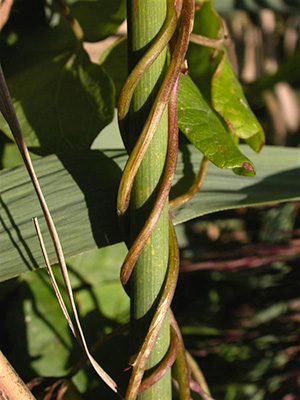Half Hectare Plots in Temperate Forest Ecosystems
Using teams of 3-4 people, we select a 0.5 hectare plot (50 x 100m) in forested ecosystems that show little influence from logging or other human disturbance (e.g., vine “management”, extensive trails, farming, etc. ) in the past 75 years. The site is gridded into 10 x 10m cells. Each cell is censused for ALL climbing plants (vines, lianas) in the cell. For stems larger than 0.5cm at 1.3m above their rooting position, stems are mapped to exact position within the 10 x 10m cell, stem diameter is noted at two positions, species are identified, and the tree (or stump) on which the climber is growing is identified. For stems smaller than 0.5cm at 1.3m above their rooting position, we note the species as “present” in the cell, but do not take data on abundance or position within the 10 x 10m cell.
Determining Twining Direction
Dextral: When viewing the plant from its base, it will seem to be proceeding in a clockwise direction. This is sometimes referred to as “left to right.” If you place your thumb in the direction the plant is growing, it will curl the way the fingers on your right hand curl. Darwin sometimes calls this “with the sun.”
Example: Calystegia sepium
Sinistral: When viewing the plant from its base, it will seem to be proceeding in a counterclockwise direction. Sometimes it is referred to as “right to left.” If you place your thumb in the direction the plant is growing, it should curl the way the fingers on your left hand curl. Darwin may refer to this as “opposed to the sun.”
Example: Polygonum convolvulus



